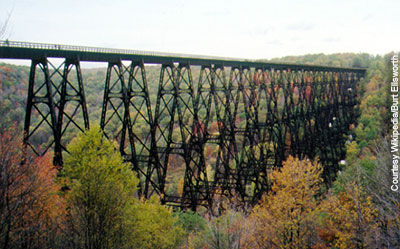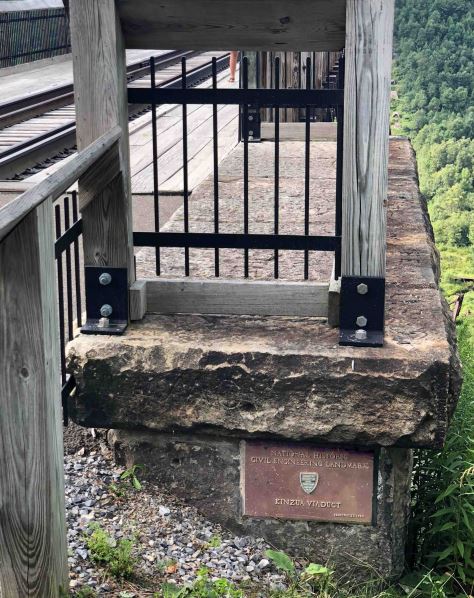Kinzua Railway Viaduct
41 45 47.3 N
78 35 21.2 W

Constructed in only 102 days, the Kinzua Railway Viaduct was by far the highest (302 feet) and the longest (2,053 feet) viaduct in the world at that time.
The workforce consisted of less than 100 men, yet they finished construction in just 94 days. Such speed was possible due to the elimination of scaffolding. Instead, iron rods were used to support construction of the trusses between the towers, and workers moved back and forth across the rods. A dangerous venture, yet no workers were seriously injured.
The Kinzua Railway Viaduct, built by the New York, Lake Erie & Western Railroad, was an iron trestle bridge spanning the Kinzua Valley. It was a critical structure in facilitating the transport of coal from Northwestern Pennsylvania to the Eastern Great Lakes region, and is credited with causing an increase in coal mining that led to significant economic growth.
Upon completion, it was the highest and longest railroad bridge in the world. The rails were 301 feet above the valley, with a total length of 2,052 feet. The $275,000 viaduct required a record-breaking 3.5 million pounds of iron.
By 1900, railroad engines were nearly 85% heavier, exceeding the capacity of the iron structure; so a steel replacement bridge was built using the original foundations. Freight service over the bridge ceased in 1963, and the bridge and surrounding area were designated the Kinzua Bridge State Park. On July 21, 2003 a tornado touched down by the viaduct causing 11 out of the 20 towers to collapse. The failures were caused by the badly rusted base bolts holding the bases of the towers to concrete anchor blocks embedded into the ground.Today with a new observation deck and visitor's center, the bridge offers pedestrians an exceptional view of the Kinzua Valley.
Facts
- Twenty iron towers supported the roadbed.
- Six of the towers were higher than those of the Brooklyn Bridge.
- Each tower was composed of four wrought-iron columns.
- The bridge required 110 masonry piers.
- The bridge was 10 feet wide along the top, but the tallest of the towers spreads to 103 feet at the base, giving the structure considerable stability.


